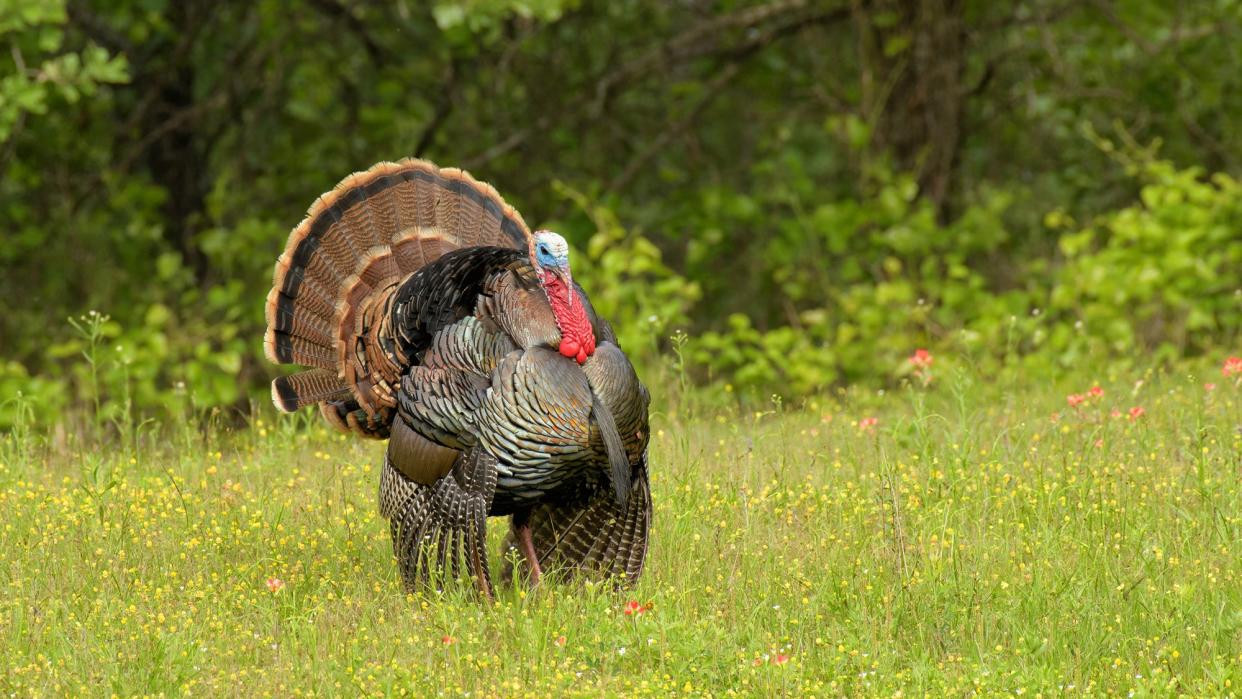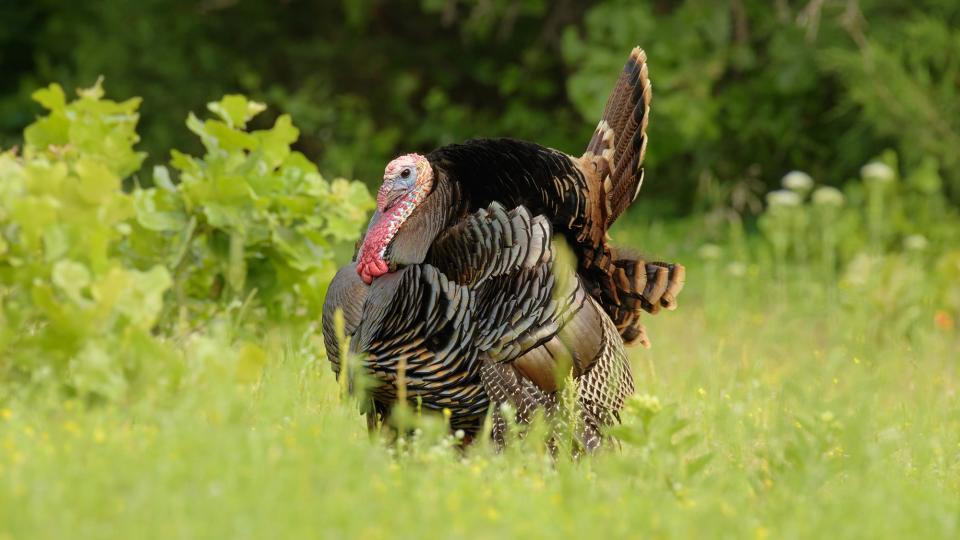How to Identify and Hunt the Rio Grande Wild Turkey

Known for its hard-gobbling nature, the Rio Grande wild turkey is commonly found in West Texas, Oklahoma, and Kansas. However, smaller populations inhabit areas across Northern California, Oregon, and other southwest states. These birds are easily identified by their tan or buff tail feathers and are smaller than the more common Eastern wild turkey. Geographically speaking, the Merriam's wild turkey is their closest relative, and hybridization is common in areas where the two populations overlap.
Although Rios aren't as widespread as Easterns, hunters who pursue this smaller subspecies often encounter toms gobbling their heads off. While this can make for an exciting hunt, Rio hunters emphasize the importance of staying off the roost as these birds are easily spooked. But when hunted properly, Rio Grande wild turkeys gobble hard, come long distances, and put on a show for hunters hiding in the brush. Below is a beginner's guide to Rio Grande turkey identification, habitat, and range, plus a few Rio-specific turkey hunting tips.

Appearance
The easiest way to identify a Rio is by its tan or buff tail feathers. These feathers are darker than the snow-white tips of a Merriam's turkey but still lighter than an Eastern's or Osceola's tail feathers. Rios weigh less than Eastern turkeys, with the toms averaging around 20 pounds and the hens around 8 to 13 pounds. Spur and beard lengths are moderate in length, falling short of an Eastern's, but longer than a Merriam's. Rio turkeys aren't the loudest, but are known for gobbling a bunch. They feature long legs and greenish-copper body feathers. Rios also have the same amount of black and white barring on their wings compared to Easterns and Merriam's.
Rio Grande Wild Turkey Range and Habitat
Texas has long been the hotbed for hunting Rios. While the Lone Star State still maintains a healthy bird population, excellent Rio hunting can be found elsewhere in Oklahoma, California, Oregon, Kansas, and Colorado. Eastern Washington, too, has great Rio Grande activity, particularly due north of the city of Spokane.
Rio Grande habitat depends on geographic location. In eastern Washington, for instance, birds can be found in a mix of ponderosa pine and short brushy scrub oaks, along river valleys, and on edges where timber and open pasture or agriculture meet. In Texas, areas with stands of mesquite interspersed with relatively open rangeland or scrub brush hold birds. Shorter vegetation protected by brush piles or downed timber is conducive to nesting success.
Due to the often arid environments in which they live, the key to productive habitat is water. Smaller ponds, seeps, wild springs, creeks, and rivers provide a consistent source of water for Rios. However, where Mother Nature dries up her existing sources each summer, man-made structures, including stock tanks and/or windmills, are certainly beneficial and, sometimes, life-saving.
Population Status
According to the Department of Wildlife and Fisheries Sciences at Texas A&M University, the Lone Star State is home to from 500,000 to 600,000 Rio Grande turkeys, with an estimated annual harvest of around 100,000 birds. Despite recent wildfires, California’s Rio population is stable and expanding in some locales. Likewise for eastern Washington and all of Oregon, particularly in the Beaver State’s southwest and northeast corners.
Unfortunately, not all is rosy. Oklahoma’s Rio population, for example, has been declining since a severe drought hit the state in 2011-12, causing turkey numbers to drop dramatically. As a result, wildlife officials have shortened the spring hunting season and dropped the bag limit from two birds to one.
Hunting Tactics for Rio Grande Wild Turkeys
For hunters chasing the grand slam, Rio Grande turkeys are one of the more localized subspecies. Texas and Oklahoma are still two of the top states to chase these birds, but the Pacific Northwest and other states like Colorado and Kansas are gaining popularity. Once you have your location picked out, it's time to fine-tune your hunting skills and make small adjustments to dial in on the Rio's habitat and behavior. Here are four Rio Grande-specific turkey hunting tips:
1. Don't Bust the Roost
If you're used to hunting Eastern turkeys, then you are probably familiar with the tactic of sneaking in close to the roost. While that might work for longbeards back east, Rios are more roost-sensitive. Since they tend to bunch up in groups, your odds of going unnoticed while sneaking in decline dramatically. The more eyes in the trees, the more likely you'll get busted.
So, if you hear a bunch of birds gobbling their heads off on the limb, don't go running in. Get set up far enough away that you won't disturb the roosting area, and try to call one in once they fly down. Rios will often use the same area to roost each night, so the last thing you want to do is blow it out. Leave their bedroom alone and let them come to you.
2. Focus on Water, Food, and Stut Zones
Due to the dry nature of the Rio turkey habitat, it is always a good move to focus on water and food sources. After flydown, these birds will make their way toward water, food, and strutting areas. Creek beds and river bottoms are excellent places to locate birds. Open areas with nearby cover are also prime locations to find toms looking to show off.
3. Don't Be Afraid to Get Loud
High-pitched frequencies travel farther and arrive at their destination with greater clarity than lower pitches. That said, and due to the often expansive nature of Rio habitat, high-pitched locator calls, like pileated woodpecker calls, peacock calls, and coyote howls, often have the ability to solicit a gobble from long distances better than traditional owl or crow calls. The same goes with turkey sounds; crystal, glass, or aluminum surfaced pot-style calls are often winners in open country.
4. Go Find Another Bird
One of the best parts about hunting Rios is you often get a second or third chance in a day. Just because you blew it on one or two birds doesn't mean the hunt is over. Since Rios tend to stay in larger groups, there's a good chance a fresh bird is over the next hill. Don't be discouraged if a single tom busts you. As long as you don't blow out the roost, you'll have a good chance of finding more birds and potentially calling in multiple gobblers.

